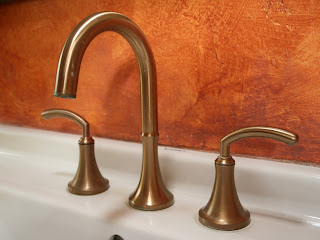Today I had my water saver pre-inspection to see what needed to be changed to pass inspection to get some of that rebate money. I knew some things would pass, like the dual flush toilet (1.6 and .9 gallons per flush) and the single 1.6 gpf toilet (that seemed SO water saving a few years ago…..and I guess it was compared to what we had before). There is no money for changing out to a 1.28 as so little water savings would ensue it wasn't included as a recommendation to do in the report that was generated to pick the best ways to save (see the Maddaus Report OR "Water Conservation Implementation Plan for The Los Osos Wastewater Project").
More of concern were the fixtures in the bathrooms and the faucet in the kitchen. There seemed to be no way to modify them at all and it was depressing to think that the fancy fixtures that we spent days picking out (and a fair amount of money on) might need to go to recycle-land.
So the appointed hour arrived and the young woman water auditor arrived and the tests began. She used a 5-gallon paint bucket (mostly to carry the measuring device—to keep water off your floors, although there was a chart on the side which she consulted once) and what looked like a mixer bowl for making pancakes with a handle and measurements marked on it. She held the mixer bowl under the water flow and timed the water coming from each shower and faucet. The amount in the bowl indicated either a pass or a no-pass. She was quite fast about doing the whole thing, and really nice answering all of my dopey questions too.
Here's what I learned:
• The amount the fixture says it will deliver on the literature varies in reality greatly. Two identical bathroom faucets delivered different amounts, (both under the limit, thank goodness). Not sure if the difference was a change in water pressure in the two locations, or because one spout is deck mounted and one is wall mounted.
(The camera lens is exaggerating the spout diameter, it is uniform!)
• Both our showerheads are identical models, but the valve on one is fixed, the water is on or off, you adjust the temperature by rotating the handle (this one did not pass at almost 3 gpm) and the valve on the other, while rotating to the desired temperature, also pulls out to give more or less of a spray (this one passed at almost 2gpm).
• The kitchen sink faucet, rated to go up to 2.2 gpm with no apparent way to add an aerator, did not pass with an output of slightly over 2 gpm, but it can be modified by removing a little plastic disc in the center and putting in an aerator! Thank goodness. That one was another agonizing fixture to pick out. A $5.00 rebate applies and I am good with that.
• If a plumber can find a way to restrict the output on the one shower that is at almost 3gpm to down 2 gpm or less, it will pass inspection, but no rebate as it will not be replaced. I will find out and report later.
• Fixtures deliver water influenced by water pressure in the neighborhood and in your individual house too. What the fixture is rated to deliver is only the maximum it could deliver, not what it will deliver.
• New showerhead designs are coming out all the time, so if nothing matches the style that you have now, you might wait a bit and find one a little later on.
• So now what else can I do to save water and get a rebate? Our dishwasher is new, so it already saves water, no need to replace that. And the only way to have gotten money toward a recirculating pump (my first choice for an improvement) was to have both toilets at 1.28 or less and all faucets at 1.5 gpm, so we didn't quality there. But our washer is a top-loading antique. That is our best bet for the $150 rebate level.






No comments:
Post a Comment